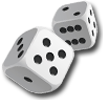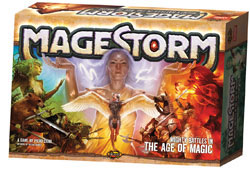



play board games
Board game reviews, strategy tips & session reports
Magestorm Review
 Stats:
Stats:
No. of players: 2
Amount of time to play: 60-120 min (depending on the scenario)
Age requirements: 12+
Set-up time: 10-20 minutes (depending on the scenario)
Magestorm Rules Description:
Magestorm is a fantasy war game where magic has a major effect on the battle. You control troops and a powerful mage to form a potent army. Your opponent will do the same can you best them?
Magestorm is a medium weight war game set in the fantasy world of Aleen. The base game comes with two factions the Lausian and the Kragis. You also receive four different mages: the fire mage, druid, air mage, and fate guardian. And there are 10 scenarios that come with Magestorm.
To begin the game you must setup the board according to the scenario you are playing. More importantly you will be given a certain number of troops. These troops are represented by cards. Some are better at range, some are slow but hit hard and others are able to absorb a lot of damage. You must arrange these troops into units and each unit may contain 3-6 troops.
Each turn you have five phases: the Magic phase, Strategic phase, Movement phase and Combat phase.
You will have a mage board based on which mage you are using. During the Magic phase you may move current power points around the mage board. Having a power point on a spell allows you to cast it. Stronger spells are further away from where you initially place your power points. So the stronger a spell the longer it takes to cast. At the end of the Magic phase you generate more power points (based on the scenario).
The Strategic phase consists of casting strategic spells and spending your strategic points. Strategic spells may be cast if you have a power point on that spells space on your mage board. Depending on the scenario and army are playing you will get either 4 or 5 strategic points. You spend these points to place or move objectives, hold your units in place or change the structure of your units.
The Movement phase is when your units move (I know, big surprise). Units will move toward the closest objective marker unless they have a hold order. They also stop if they don’t have enough movement points to get into the terrain they are entering or if trying to enter a hex with an enemy army.
If you are trying to enter an enemy’s hex Combat occurs. Combat consists of 10 steps, so I am not going to detail them all. Basically, during combat you can cast spells to buff your units and summon creatures to fight with you. You then roll initiative whoever wins the initiative roll attacks while their opponent defends. Damage may remove some troops from the defender and then they become the attacker.
You do this once to represent ranged combat and a second time to portray melee combat. Some troops are better at ranged combat while others excel in melee. And though both troops fight in each step they might have different stats based on what step they are in. The other difference is that melee is simultaneous. There is no initiative roll and units are not removed until both players attack and defend.
The meat of combat are the troop cards. Each troop card has the stats for that troop type on the right edge. You align these cards to only show the stats (adding spells you cast and terrain effect cards if applicable). You roll a six-sided die and add that to the total for the stat you are using based on the step.
For example if you are attacking you will roll a die and add it to your unit’s total attack. Your opponent will roll a die and add it to their total defense. If you beat their total defense, you total your unit’s damage value and inflict that many wounds on your opponent. Tying or having less attack than your opponent’s defense only inflicts 2 wounds per troop.
You continue to play through these five phases until you meet a win condition or have played a certain number of rounds. Win conditions or the number of rounds to play are scenario based.
A Quick Review of Magestorm:
I wanted to start this review by saying I have only played Magestorm a handful of times. I am still learning the strategy but thought I had enough of a grasp of the game to give an overview and talk about what I like and dislike about it. If my opinion changes after more plays I will update or pos a newer review of this game.
Magestorm has taken a couple elements from real-time strategy (RTS) games. It has a fog of war mechanic (that I didn’t mention above). When you build your units, your opponent has no idea what troops you have put in them or the exact number of troops in each unit. This adds to the variability, war-theme and fun of Magestorm.
Another aspect of Magestorm that can be found in a RTS, is objectives. Your units will move toward the closest objective you have placed on the map. This feels like a general telling his men to take a position on a hill. The unit heads that way and might encounter enemies on the way. Objectives help Magestorm replicate this dynamic in the game.
Moving power points around your mage board and waiting to cast more powerful spells is cool. There is even a limit on how many power points can be moved to a spell per turn. This is just a very innovative magic system that doesn’t bog play down.
Another great feature in Magestorm is the cards. The art is awesome and the layout of the cards is very clever. During combat everything you need is on the right edge of the cards. So lining them up you can see all the info for your troops that you need.
Strategic points are another great way to show an armies superior training. Having more strategic points allows you to better plan your units’ movement. Again I really think this adds to the depth of the game.
As with most games of this type, it will be slow going at first. But after a couple plays things should flow better. Some players do not like the objective markers as you may not have exact control over your units.
Magestorm is a lot of fun and is a great fantasy-themed, mid-weight war game. There is both strategic and tactical depth in how you compose your units and how you then use them. I really like the innovative ways Nexus Games has implemented the magic, combat and movement. I highly recommend picking up Magestorm and am looking forward to its expansions.
Score and synopsis: (Click here for an explanation of these review categories.)
Strategy 4 out of 6
Luck 3 out of 6
Player Interaction 5 out of 6
Replay Value 5 out of 6
Complexity 4 out of 6
Fun 5 out of 6
Overall 5 out of 6

Leave a Reply